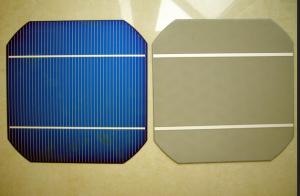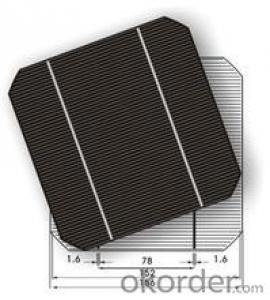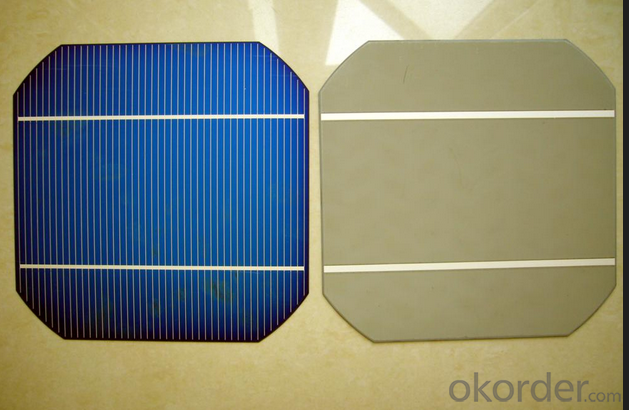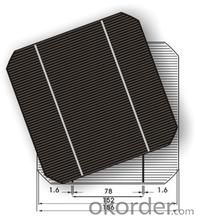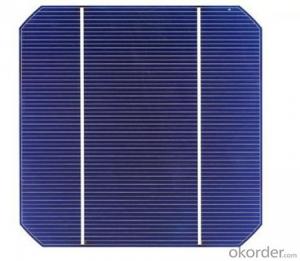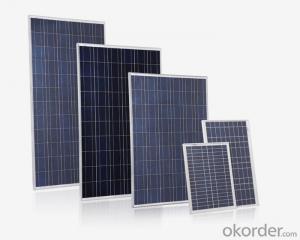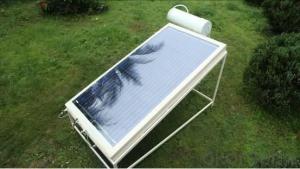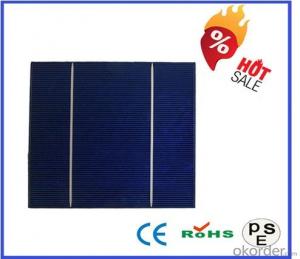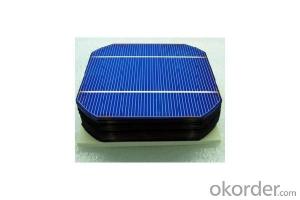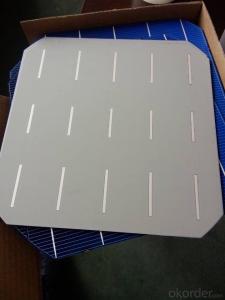Longi High Energy Conversion Efficiency Monocrystalline Silicon Solar Cells with Low Price
- Loading Port:
- China main port
- Payment Terms:
- TT or LC
- Min Order Qty:
- 1 m²
- Supply Capability:
- 100000000000000 m²/month
OKorder Service Pledge
OKorder Financial Service
You Might Also Like
1. Monocrystalline Silicon Solar Cells
OKorder is offering high quality Monocrystalline Silicon Solar Cells at great prices with worldwide shipping. Solar cells are the core of solar power systems and our Monocrystalline solar cells consist of an anisotropically texturized surface and dark silicon nitride, anti-reflection coating and a full-surface aluminum back-surface field. These Monocrystalline solar modules are perfect for converting solar energy into electric energy, or charging storage batteries.
2. The intended use of Monocrystalline Silicon Solar Cells
Our Monocrystalline Silicon Solar Cells are ideal for:
Power generation
Lighting
3. The advantages of Monocrystalline Silicon Solar Cells
Not only are OKorder's Monocrystalline Silicon Solar Cells of the highest quality and reliability, we are able to quickly ship orders within 20 days of receiving a deposit or original L/C.
4. Main features of Monocrystalline Silicon Solar Cells
Extended service life
Outstanding power output even in low light or high temperature conditions
High energy conversion efficiency
Reliable performance
Color uniformity
Low breakage rate
Optimized design for ease of soldering and lamination
5. FAQ:
Q1: Why buy Materials & Equipment from OKorder.com?
A: All products offered byOKorder.com are carefully selected from China's most reliable manufacturing enterprises. Through its ISO certifications, OKorder.com adheres to the highest standards and a commitment to supply chain safety and customer satisfaction.
Q2: What is a solar cell?
A: A solar cell is an electrical device that converts light energy directly into electricity by a phenomenon called the photovoltaic effect. When exposed to light, solar cells can generate and support an electric current without being attached to any external voltage source, but do require an external load for power consumption.
Q3: What are the advantages and disadvantages of monocrystalline solar PV cells?
A: Monocrystalline solar cells are the most efficient type of PV cells, with the exception of CdTe thin film solar PV cells. As a result, monocrystalline solar cells are more expensive when compared to almost all other types of cells.
Q4: What is the typical service life of solar PV modules?
A: The typical life of a PV module is 25 years. However, superior quality PV modules boast service lives up to 35-40 years (electrical generating capacity is often reduced, however by that point).
Q5: What certifications do you have?
A: We are specialized in the photovoltaic field, with a focus on solar cells, modules and photovoltaic power generation systems. We employ advanced monocrystalline and polycrystalline silicon solar cell manufacturing equipment, producing highly efficient and reliable products sold in Europe, the Americas and Australia. Our company has passed ISO9001 quality management system certification, and our products have obtained TUV-IEC, CE, UL certification.
Q6: How do we guarantee the quality of our products?
A: We have established an advanced quality management system which conducts strict quality tests at every step, from raw materials to the final product. At the same time, we provide extensive follow-up service assurances as required.
Q7: How soon can we receive the product after purchase?
A: Within three days of placing an order, we will begin production. The specific shipping date is dependent upon international and government factors, but is typically 7 to 10 workdays.
6. Specifications:
Dimension: 156mm x 156mm
Diagonal: 200mm (round chamfers)
Front: Anisotropically texturized surface and dark silicon nitride
anti-reflection coating
1.9mm silver bus bars
Back: Full-surface aluminum back-surface field
2.0mm (silver / aluminum) continuous soldering pads

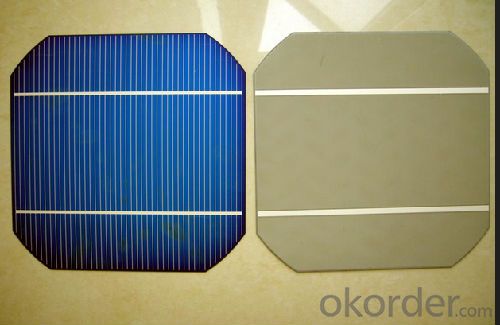
Brief introduction of Monocrystalline Silicon Solar Cells
Monocrystalline silicon solar cells based on high-purity silicon rods as raw material for solar cells, is currently the fastest development of a solar cell. Its structure and the production process has been finalized, the products have been widely used in space and on the ground.
In order to reduce production costs, ground applications such as solar cells using solar grade silicon rods, materials performance has been relaxed. Some also use semiconductor device processing materials and discard the head and tail of silicon materials, solar cells drawn into complex dedicated silicon rods. The silicon rods cut into pieces, usually 0.3 mm thick sheet. After polishing, cleaning and other processes, the raw material will be made of silicon.
In the processing of making solar cells, the first doping and diffusion in silicon, a trace amount of dopant is generally boron, phosphorus, and antimony. Diffusion is carried out in a quartz tube into a high-temperature diffusion furnace. Thus formed P> N junction on the wafer. Then using a screen printing method, fine with a good paste into a grid line printed on the wafer, after sintering, while forming the back electrode and the surface coated with antireflection gate line source to prevent a large number of photons It is reflected off the smooth surface of the wafer.
Thus, the monomer monocrystalline silicon solar cells are produced. After single-chip random testing can be assembled according to the required specifications into a solar cell module (solar panel) by the method of series and parallel to a certain output voltage and current. Finally, package the frame and materials. According to user system design, solar cell components of various sizes square solar cells, also known as solar arrays. Photoelectric conversion efficiency of monocrystalline silicon solar cells are about 15%, the results of the laboratory also has reached more than 20%.
- Q: Can solar cells be used for powering outdoor surveillance systems?
- Yes, solar cells can be used for powering outdoor surveillance systems. Solar cells convert sunlight into electricity, making them a sustainable and reliable power source for outdoor applications. This eliminates the need for traditional power sources and allows surveillance systems to operate in remote or off-grid locations. Additionally, solar-powered surveillance systems can be cost-effective and environmentally friendly, reducing energy consumption and carbon emissions.
- Q: How do solar cells convert sunlight into electricity?
- Solar cells convert sunlight into electricity through a process called the photovoltaic effect. When sunlight hits the solar cell, the photons from the sunlight energize the electrons in the cell's semiconductor material, causing them to break free from their atoms. This creates an electric current, which can then be harnessed and used as electricity.
- Q: What is the environmental impact of solar cells?
- The environmental impact of solar cells is generally positive. They produce clean and renewable energy, reducing greenhouse gas emissions and dependence on fossil fuels. However, their production does require some raw materials and energy, which can have environmental consequences. Additionally, the disposal of older solar panels may pose challenges in terms of electronic waste management. Overall, though, the benefits of solar cells outweigh their environmental drawbacks.
- Q: What is the lifespan of solar cell batteries?
- The lifespan of solar cell batteries can vary depending on various factors such as the quality of the battery, usage patterns, and maintenance. On average, solar cell batteries can last anywhere from 5 to 15 years. However, with proper care and regular maintenance, some batteries have been known to last for up to 20 years or more. It is important to consider the manufacturer's specifications and recommendations when determining the lifespan of a specific solar cell battery.
- Q: How much do solar cells cost?
- The cost of solar cells can vary depending on various factors such as the size, type, efficiency, and quality of the cells. On average, residential solar panels can cost anywhere from $10,000 to $30,000, including installation. However, it's important to note that prices have been decreasing over the years, making solar energy more affordable and accessible to a wider range of consumers.
- Q: Can solar cells be used for powering shopping malls?
- Yes, solar cells can be used to power shopping malls. With their ability to convert sunlight into electricity, solar cells can provide a sustainable and renewable energy source for shopping malls, reducing their reliance on traditional power grids and lowering their carbon footprint. Additionally, the large rooftop spaces available in shopping malls make them ideal for installing solar panels, maximizing energy generation potential.
- Q: Can solar cells be used on vehicles other than cars?
- Yes, solar cells can be used on vehicles other than cars. Solar cells can be integrated into various types of vehicles such as buses, trucks, motorcycles, boats, and even planes. These cells are used to generate electricity from sunlight, which can be utilized to power the vehicle or charge its batteries. This helps reduce reliance on fossil fuels and provides a more sustainable and environmentally friendly means of transportation.
- Q: Can solar cells be used underwater?
- No, solar cells cannot be used underwater as they rely on sunlight to generate electricity.
- Q: Is the solar cells factory in China good and trustworthy?
- Most of the solar cells factories are good and trustworthy because the high requirements of the Chinese government and quality standard.
- Q: How do solar cells compare to fossil fuels in terms of energy production?
- Solar cells are a more sustainable and environmentally friendly option for energy production compared to fossil fuels. While fossil fuels are limited in supply and contribute to air pollution and climate change, solar cells harness the power of the sun to generate electricity without emitting harmful greenhouse gases. Additionally, solar cells have the potential for decentralized energy production and can be installed in various locations, making them a more flexible and accessible source of energy.
Send your message to us
Longi High Energy Conversion Efficiency Monocrystalline Silicon Solar Cells with Low Price
- Loading Port:
- China main port
- Payment Terms:
- TT or LC
- Min Order Qty:
- 1 m²
- Supply Capability:
- 100000000000000 m²/month
OKorder Service Pledge
OKorder Financial Service
Similar products
Hot products
Hot Searches
Related keywords
